Daredevil Villains #48: Bullseye
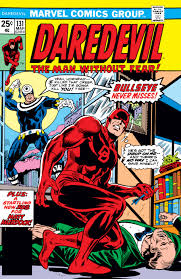 DAREDEVIL #131-132 (March & April 1976)
DAREDEVIL #131-132 (March & April 1976)
“Watch Out for Bullseye, He Never Misses!” / “Bullseye Rules Supreme”
Writer, editor: Marv Wolfman
Penciller: Bob Brown
Inker: Klaus Janson
Colourist: Michele Wolfman
Letterer: Joe Rosen
Well, it took us 48 goes and over a decade of comics, but we’ve finally reached one of the really big names. We’ve had enduring second-tier villains like the Gladiator, the Jester and the Owl. We’ve had some villains who were big deal for a short time, like the Masked Marauder and the Death-Stalker. And we’ve had a whole bunch of one-off villains. But truly A-list villains? There’s the Purple Man, perhaps, but his claim to that status rests largely on stories published long after he stopped appearing in Daredevil.
Bullseye is in a different position. He still appears in Daredevil today. He’ll get his own minis. He’s a recognisable figure around the Marvel Universe. He’ll even make it to the Dark Avengers. But it’ll take him a little time. He made it into the first Official Handbook of the Marvel Universe but didn’t make the cut for the Deluxe Edition – which means he was ranked below the likes of the Death-Throws, a team of evil jugglers. He didn’t get back in until Update ’89. So why didn’t he click immediately?
Daredevil Villains #47: Brother Zed
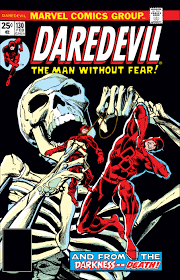 DAREDEVIL #130 (February 1976)
DAREDEVIL #130 (February 1976)
“Look Out, DD – Here Comes the Death-Man!”
Writer, editor: Marv Wolfman
Penciler: Bob Brown
Inker: Klaus Janson
Colourist: Michele Wolfman
Letterer: John Costanza
Once again, we’ve skipped some issues. Issues #126-127 are the debut of the Torpedo, a rookie rival superhero who does the obligatory misunderstanding-and-fight routine. He actually had some legs: he returns in issue #134 as a supporting character, then gets a try-out as a solo hero in Marvel Premiere , and finally winds up as a supporting character in Rom. But he’s not a villain, so he’s outside our remit. Issue #128 is another Death-Stalker story. And issue #129 brings back the Man-Bull.
In fact, focussing on the new villains will give us a rather unrepresentative view of Marv Wolfman’s run. He’s the first writer who seems to have looked at Daredevil’s pre-established rogue’s gallery and deemed them to be basically serviceable. There are only a handful of new villains in his run. And one of them is a very big name, but we’ll get to him.
It’s not that Wolfman didn’t create new characters for the book. He absolutely did, but they were mostly supporting characters. As well as the Torpedo, the issues we’ve skipped introduce Daredevil’s new love interest, Heather Glenn. We might not have much reason to talk about her here for a while, since her first major storyline involves the Purple Man, but she’s a major character who’ll stick around well into the 1980s. At this point, she’s a sort of prototype manic pixie dream girl.
Daredevil Villains #46: Copperhead
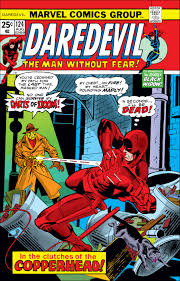 DAREDEVIL #124-125 (August & September 1975)
DAREDEVIL #124-125 (August & September 1975)
“In the Coils of the Copperhead” / “Vengeance is the Copperhead”
Writers: Len Wein (#124 part 1) & Marv Wolfman (#124 part 2 & #125)
Pencillers: Gene Colan (#124) and Bob Brown (#125)
Inker: Klaus Janson
Colourists: Michelle Wolfman (#124) and Klaus Janson (#125)
Letterers: Joe Rosen (#124) and John Costanza (#125)
Editor: Len Wein
Tony Isabella lasted only five issues on Daredevil before editor Len Wein removed him from the series. The next issue, issue #124, opens with the Black Widow departing – again, but this time it will finally stick. The narrator certainly seems to be taking the opportunity to put the boot in. “Good-bye”, he declares. “There is no sadder, more bittersweet word in all the languages of man… Good-bye: The word is truly tragic when those who say it really don’t want to say it at all.”
Issue #124 has a truly odd writing credit – instead of the usual plotter/scripter distinction, it credits editor Len Wein with writing the first half of the issue himself, with the rest being credited to Marv Wolfman. It all looks a bit shambolic and last minute. Nonetheless, this is the start of Marv Wolfman’s run, which will see us through to issue #143 before he leaves in mid-storyline.
Daredevil Villains #45: Blackwing
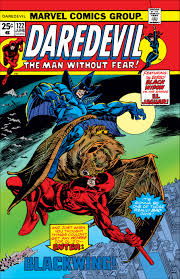 DAREDEVIL #122-123 (June & July 1975)
DAREDEVIL #122-123 (June & July 1975)
“HYDRA-and-Seek” / “Holocaust in the Halls of HYDRA”
Writer: Tony Isabella
Artist: Bob Brown
Inker: Vince Colletta
Letterer: Karen Mantlo
Colourists: Janice Cohen (#122) and George Roussos (#123)
Editor: Len Wein
Blackwing is a bat-themed villain. That might seem like a bold move in the world of superhero comics, where the bat motif is very much taken. Of course, you can always do “what if Batman, but a villain”. But for the Marvel Universe, that character is Nighthawk, and he exists already.
Yet Blackwing genuinely is distinct from Batman. For all that Batman loves his bat motif, you see, he draws the line at actual bats. Even in the days when Bat-Hound and Bat-Mite seemed like a good idea, DC drew the line at Bat-Bat. This is the gap in the market which Blackwing seeks to fill: a bat-themed villain with actual bats.
For our purposes, I’m treating these two issues as Blackwing’s spotlight story. But his debut was in issue #118 – a fill-in story by Gerry Conway and Don Heck entitled “Circus Spelled Sideways Is Death”. This magnificent title is all the better for its irrelevance: the story features neither death nor sideways orientation. It does, however, feature a circus.
Daredevil Villains #44: El Jaguar
 DAREDEVIL #120 (April 1975)
DAREDEVIL #120 (April 1975)
“…And a HYDRA New Year!”
Writer: Tony Isabella
Artist: Bob Brown
Inker: Vince Colletta
Colourist: Petra Goldberg
Leterer: Ray Holloway
Editor: Len Wein
Aside from the Crusher issue that we covered last time, Tony Isabella’s short run on Daredevil consists of a HYDRA storyline. These few issues are certainly not enough to make HYDRA into Daredevil villains. But if Isabella had stuck around longer, they might well have wound up as a true import to his rogue’s gallery. Isabella’s big project here is to retool HYDRA for the seventies, and Daredevil happens to be the book he’s writing so here they are.
HYDRA had debuted a decade earlier in “Nick Fury, Agent of SHIELD” (at that point, a feature in Strange Tales). They were a terrorist organisation led by Fury’s arch enemy Baron Wolfgang von Strucker, who had started life as a Nazi villain in Sgt Fury #5. In other words, as originally conceived, they were continuity Nazis. If not outright neo-Nazis, they were at least an example of the “escaped Nazi leader resurfaces in South America with a private army” trope.
But Strucker had been killed in Strange Tales #158, back in 1967. HYDRA had continued to appear, but my impression is that without their frontman, they’d drifted into mere generic super-terrorists.
Daredevil Villains #43: The Crusher
 DAREDEVIL #119 (March 1975)
DAREDEVIL #119 (March 1975)
“They’re Tearing Down Fogwell’s Gym!”
Writer: Tony Isabella
Artist: Bob Brown
Inker: Don Heck
Letterer: Dave Hunt
Colourist: Stan Goldberg
Editor: Len Wein
We’ve skipped issues #116-117, an Owl story which ends Steve Gerber’s run with a final trip back to San Francisco, in order that the west coast supporting cast can be formally written out. The Black Widow decides to stay there, but the book finds it remarkably difficult to give her the boot, and we’ll see her one more time before she officially departs. We’ve also skipped issue #118, which is a Gerry Conway fill-in issue featuring the Circus of Crime. It also introduces Blackwing as a new member of the Circus, but he gets a solo story shortly, so we’ll come back to him for that.
With that, we’ve arrived at the blink-and-you’ll-miss-it Tony Isabella run, which lasted a whole five issues before he was removed from the book. Most of it is a HYDRA story, but Isabella kicks off by taking Daredevil back to his roots.
Daredevil Villains #42: Death-Stalker
 DAREDEVIL vol 1 #113-115 (September to November 1974)
DAREDEVIL vol 1 #113-115 (September to November 1974)
“When Strikes the Gladiator!” / “A Quiet Night in the Swamp!” / Death Stalks the City!”
Writer: Steve Gerber
Penciller: Bob Brown
Inker: Vince Colletta
Letterers: Artie Simek (#113), Charlotte Jetter (#114-115)
Coloursts: Linda Lessmann (#113), Stan Goldberg (#114), Petra Goldberg (#115)
Editor: Roy Thomas
For our purposes, this is the end of Steve Gerber’s run. It doesn’t actually end until issue #117, but the last two issues are an Owl story. Gerber’s contributions to the rogues’ gallery end here, with the Death-Stalker.
Technically I’ve covered the Death-Stalker already. In issue #158, he will be revealed to be the Exterminator, a villain who had appeared in a single storyline in 1968. I haven’t read that issue yet, but since it’s removed from Death-Stalker’s debut by four years and three writers, it seems like a safe bet that Gerber intended the Death-Stalker to be a new character. So that’s how we’ll treat him.
The story emerges from a subplot which has been building for a while now, involving Foggy Nelson’s younger sister Candace, the token liberal in her family. Candace is a journalism student and she’s stumbled upon some documents about an abandoned research project involving Ted Sallis. None of the Daredevil characters know what Sallis is up to now, but we know that he’s the Man-Thing, and that Steve Gerber is writing that book too. This storyline isn’t a crossover, but it is an excuse for the Man-Thing to guest star.
Daredevil Villains #41: Black Spectre
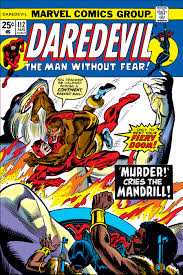 DAREDEVIL #108-112 (March to August 1974)
DAREDEVIL #108-112 (March to August 1974)
“Cry… Beetle!” / “Dying for Dollar$!” / “Birthright!” / “Sword of the Samurai!” / “Death of a Nation?”
Writer: Steve Gerber
Penciller: Bob Brown (#108-109, 111), Gene Colan (#110, 112)
Inker: Paul Gulacy (#108), Don Heck (#109), Frank Chiaramonte (#110), Jim Mooney (#111), Frank Giacoia (#112)
Letterer: John Costanza (#108), Artie Simek (#109-110), Tom Orzechowski (#111), Annette Kawecki (#112)
Colourist: Petra Goldberg (#108-109, 112), Linda Lessmann (#110-111)
Editor: Roy Thomas
There are several noteworthy things about the Black Spectre arc. On the most basic level, it takes the book back to New York. Foggy Nelson, who we haven’t seen since issue #87, has been shot by a sniper, and Matt Murdock returns to Manhattan to help out. At first, the story presents this as a brief visit. But Matt won’t go back to San Francisco until issue #116, and even then it’s just to tie up loose ends. The reality is that from issue #108 onwards, this is a New York book again.
As for Moondragon, who was introduced with great fanfare in the last story, she’s instantly written out.
But that’s not the most striking thing about the storyline. Until now, Steve Gerber’s Daredevil has been a fairly normal comic, at least by the standards of Steve Gerber. Sure, there’s Angar the Screamer and his LSD powers. But the book has mostly stayed within normal Marvel parameters. Even when it’s ventured into stranger territory, it’s drawn on Jim Starlin concepts.
Daredevil Villains #40: Kerwin J Broderick
 DAREDEVIL #104-107 (October 1973 to January 1974)
DAREDEVIL #104-107 (October 1973 to January 1974)
“Prey of the Hunter!” / “Menace From the Moons of Saturn!” / “Life Be Not Proud!” / “Blind Man’s Bluff!”
Writer: Steve Gerber
Penciller: Don Heck (#104-106), Jim Starlin (#105 Titan sequence), Bob Brown (#107)
Inker: Sal Trapani (#104, #106), Don Perlin (#105), Sal Buscema (#107)
Letterer: Charlotte Jetter (#104, #107), June Braverman (#105), Shelly Leferman (#106)
Colourist: Petra Goldberg (#104, #107), Janice Cohen (#105), George Roussos (#106)
Editor: Roy Thomas
Throughout Steve Gerber’s run, a mysterious shadowy figure has been giving super powers to oddballs like Angar and the Dark Messiah. Now, it’s time for Daredevil to meet this arch villain. It’s Kerwin J Broderick, the senior partner of the law firm of Broderick, Sloan and Murdock.
Until now, Broderick hasn’t been seen on panel, but Gerber has been building him up in a subplot. Matt is hired to defend a group of kids who are charged with robbery, and Jason Sloan keeps telling Matt that Broderick wants him to enter a guilty plea. The expectation seems to be that Matt Murdock, of all people, won’t merely persuade his clients to plead guilty, but will actually ignore their instructions. It’s a strange arc, since Gerber seems to think that this sort of thing would be classed as “slightly questionable” rather than “completely beyond the pale”, meaning that Matt reacts to it as simply a troublesome work problem.
Daredevil Villains #39: Ramrod
 DAREDEVIL #103 (September 1973)
DAREDEVIL #103 (September 1973)
“…Then Came Ramrod!”
Writer: Steve Gerber
Penciller: Don Heck
Inker: Sal Trapani
Letterer: Artie Simek
Colourist: George Roussos
Editor: Roy Thomas
We’ve skipped issue #102: it’s a fill-in by Chris Claremont and Syd Shores, and the villain is Stilt-Man. And now, back to the storyline in progress.
Daredevil has been working his way through a series of new supervillains, all created as henchmen by a mystery archvillain. Daredevil has already faced the nebulously religion-themed Dark Messiah, and psychedelic oddball Angar the Screamer. Ramrod is the next in the series.
What is a ramrod, anyway? Good question! Well, it’s a stick for ramming things into a gun barrel. You probably have one at home for your own musket. But in America, it also means a foreman who’s a strict disciplinarian. That’s presumably the sense that Steve Gerber had in mind, since Ramrod’s extremely token origin story has him as an obnoxious foreman on an oil rig. When he gets crushed by an oil drum, he’s taken to the same hospital where Mordecai Jones became the Dark Messiah a few issues back. The same shadowy villain carts him off, gives him superpowers, and tells him to kill Daredevil.
